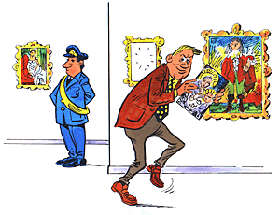 Along with the rise of online auctions and sales, the art world has seen an increase in fraud. This type of crime generally manifests in two different ways: reproductions that sell as originals or fabrications that are attributed to well-known artists.
Along with the rise of online auctions and sales, the art world has seen an increase in fraud. This type of crime generally manifests in two different ways: reproductions that sell as originals or fabrications that are attributed to well-known artists.
The New York Times just published an article on this type of fraud. They illustrated the scenario with a “Picasso” that sold for $450.00 on eBay. Would you buy such a thing? Should you? I suppose it depends. If you want to believe there’s a chance you snagged a Picasso for $450.00 dollars and the item that you framed represents a hope and a dream, then why not? In this sense, it’s not much different from a lottery ticket. Your numbers won’t come in and the item you bought is not a Picasso. But, hey, I guess you never know.
For better results, you should develop a plan before you buy. This will help you create a more worthy endeavor and make you less susceptible to holy-shit-there’s-a-Rembrandt-for-300-dollars-on-eBay!!1!! Apart from fraud protection, there’s another upside to this type of strategy: a collection is more valuable and interesting than a random assortment of art.
The first step is to decide what to collect. This well help narrow your focus and make it easier to develop expertise. While it’s a daunting task to master 19th Century French poster making, it’s much simpler to digest that niche than the entire history of human art.
The next step is to tread lightly into the art world. Talk to dealers and collectors. Submerge yourself in forums and discussion groups. At this point, you want to learn how to evaluate, select and interact with dealers. You want to learn how to handle yourself and establish a good relationship. Trust me on this. A good relationship with a trustworthy dealer is priceless. As your relationship blossoms, you’ll find yourself on the receiving end of exclusive offers which are consistent with the strategy you developed in step one.
Next you want to research the art itself. Learn how to evaluate its provenance and its condition. Make sure you look at many examples of the artist’s work. Once you’re very familiar with an artist, it becomes much easier to spot a fake. If the style doesn’t feel right that should give you reason for pause. Some artists go through many metamorphic changes over the course of a career. Hermann-Paul is a great example. But I won’t buy these outliers without good provenance or the support of a reputable dealer.
There are no guarantees but if you follow these steps you should be ready to buy. Happy collecting.
[NYT: A Picasso online for $450? It’s a steal – via The Age to save you a click]
